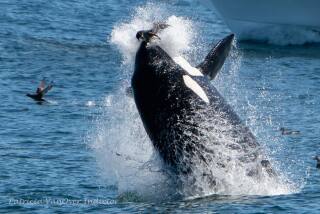Call of the Beach : Grunion Spawning Runs a Frolicking Good Time
- Share via
On certain nights and on certain beaches this summer, the sands at surf line will “suddenly be transformed into hordes of silvery fish, glistening wet in the moonlight.”
With those words, state Department of Fish and Game spokesman Pat Moore described the upcoming annual runs of the grunion--tasty little tidbits that may be caught only by hand--which begin Saturday on Orange County beaches and other strands between Santa Barbara and the Mexican border.
Broad, quiet beaches, such as those at Sunset Beach, Huntington Beach, parts of Newport Beach, Laguna Beach and Doheny State Beach are likely locations for the little fish to come ashore.
But Moore said that although marine biologists can forecast the time of their arrival within about two hours, there is no telling which beaches they will choose.
Grunion hunters 16 years of age or older must have fishing licenses, he said, and no implements may be used. There are no limits on the number of grunion one can catch.
“They’re a very good eating fish,” Moore said. “Just clean, scale, coat with a mixture of corn meal and flour and deep-fry until golden brown.”
Grunion runs are “extraordinary events . . . that provide a glimpse into one of nature’s most remarkable reproduction phenomena,” Moore said.
Female grunion reach the beach by swimming in with a wave, burrow tail-first into the sand and deposit their eggs, up to 3,000 at a time. Male fish immediately arrive to fertilize the eggs, then both males and females swim back to sea on the next wave. The whole process takes about 30 seconds.
Catching grunion is strictly a late-night operation because of tide conditions.
Moore said the spawning cycle begins with the arrival of a few male fish in the surf line, and he suggests that these not be disturbed, because about 20 minutes later, both males and females appear in great numbers, up to several thousand, and that is the time to start grabbing. He said a pillow case makes a good creel for holding one’s catch.
Grunion choose the moment the high tides begin to recede, Moore said, because the diminishing waves are less likely to wash away the newly deposited eggs.
“Grunion egg pockets are left to mature in the sun-warmed sand for about 10 days, at which time the next high tide occurs and washes them out to sea,” he said. “The eggs will hatch within three minutes after having been freed from their sandy nests.”
Runs are expected to start between 10:15 and 11:30 p.m. Saturday through Tuesday, lasting until 12:30 or 1:30 a.m. Then there is a break until the nights of the 19th, 20th, 21st and 22nd.
During the months of April and May, no grunion hunting is allowed, giving the fish a chance to reproduce undisturbed. The season will continue through June, July and August, with the last run of interest to grunion hunters on Aug. 17. Four-day grunion runs closely follow the new and full moons.
DO’S AND DON’TS
Wear old, warm clothes; expect to get wet.
Don’t use shovels, pails, nets or any other implements. They are not allowed.
Avoid blazing campfires and use of flashlights. They discourage grunion.
Bring something like a pillow case to hold your catch.
If you are 16 or over, you must have a fishing license.
The annual grunion run begins Saturday along the Orange County coast. Although there is no way of telling where the little fish will come ashore, the beaches shown are likely locations.
More to Read
Sign up for Essential California
The most important California stories and recommendations in your inbox every morning.
You may occasionally receive promotional content from the Los Angeles Times.













